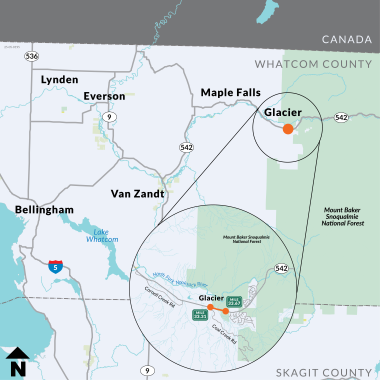The existing SR 542 bridge over Glacier Creek is in Whatcom County, supporting connections in and through the Glacier community. The current structure over Glacier Creek has a long history of channel instability, flooding, emergency road repairs, flood control projects and several bridge replacements. The existing SR 542 crossing is located on an alluvial fan and is very undersized for watershed conditions.
The WSDOT SR 542 Glacier Creek Bridge Replacement Project would design and construct a new floodplain-spanning, 880-foot-long bridge over Glacier Creek. The bridge would be continuous with a recently constructed adjacent bridge over Gallop Creek (which shares the alluvial fan), span the floodplain and alluvial fan, and eliminate 350 feet of vulnerable bridge approach fill between the two existing structures. The project would remove vulnerable WSDOT infrastructure from Glacier Creek flow paths and reduce flood and avulsion risk to SR 542.
This project is expected to reduce flood risk, ensure transportation is reliable during flood events, improve safety for the Glacier community and visitors east of the crossing and reduce the need for future emergency highway and bridge repairs. As a nature-based solution, it would also improve threatened salmon habitat by restoring the floodplain processes that are vital for maintaining healthy aquatic ecosystems as well as including active transportation facilities to meet WSDOT’s complete streets requirements.
Complete streets
The Complete Streets legislation was passed in 2022, in Washington Senate Bill 5974. Using the WSDOT’s Complete Streets approach, this project will go through a Complete Streets Pre-design phase to determine the SR 542 corridor cross-section between milepost 33.31 to 33.67. The cross-section includes lanes for cars, buses, and trucks and facilities for bicyclists and pedestrians, all in one plan. The pre-design phase of the project will include significant community engagement to understand the needs of tribes, overburdened communities, multimodal users, ferry passengers, residents and other interested parties in the area.
The intent of the SR 542 Glacier Creek- Complete Streets Pre-Design phase is to create a corridor that accommodates all users (pedestrians, bicyclists, transit users and motor vehicle drivers) as well as provide improved connections to key destinations including the community of Glacier, National Forest lands, USFS Public Service Center and residential neighborhoods. The public and interested parties will have opportunities to give input on the model accommodations that will be incorporated into the new SR 542 bridge.
Healthy Environment for All (HEAL) Act
This project is also subject to Washington's environmental justice law, known as the Healthy Environment for All (HEAL) Act, which requires WSDOT to conduct EJA for SAAs. SAAs are actions initiated after July 1, 2023, and consist of WSDOT transportation projects and grants of $15 million or more, new grant or loan programs, agency request legislation and rulemaking.
Environmental justice in Washington State, as provided in the HEAL Act, addresses disproportionate environmental and health impacts in all laws, rules, and policies by prioritizing vulnerable populations and overburdened communities, the equitable distribution of resources and benefits, and eliminating harm (RCW 70A.02.010)
Agency, Tribal and Community Engagement
Agency, Tribal and Community engagement will be conducted throughout the project. Specific engagement opportunities will be updated as the project advances.
Hazard Mitigation Grant Program Funds: $36,440,000
Washington State Military Department (DHS) and Federal Emergency Management Agency (FEMA)
Phase 1:
State: $298,100
Federal: $2,827,857
Local: $0

